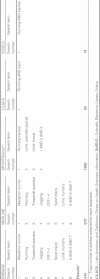What are the main running-related musculoskeletal injuries? A Systematic Review
- PMID: 22827721
- PMCID: PMC4269925
- DOI: 10.1007/BF03262301
What are the main running-related musculoskeletal injuries? A Systematic Review
Abstract
Background: Musculoskeletal injuries occur frequently in runners and despite many studies about running injuries conducted over the past decades it is not clear in the literature what are the main running-related musculoskeletal injuries (RRMIs).
Objective: The aim of this study is to systematically review studies on the incidence and prevalence of the main specific RRMIs.
Methods: An electronic database search was conducted using EMBASE (1947 to October 2011), MEDLINE (1966 to October 2011), SPORTDiscus(1975 to October 2011), the Latin American and Caribbean Center on Health Sciences Information (LILACS) [1982 to October 2011] and the Scientific Electronic Library Online (SciELO) [1998 to October 2011] with no limits of date or language of publication. Articles that described the incidence or prevalence rates of RRMIs were considered eligible. Studies that reported only the type of injury, anatomical region or incomplete data that precluded interpretation of the incidence or prevalence rates of RRMIs were excluded. We extracted data regarding bibliometric characteristics, study design, description of the population of runners, RRMI definition, how the data of RRMIs were collected and the name of each RRMI with their rates of incidence or prevalence. Separate analysis for ultra-marathoners was performed. Among 2924 potentially eligible titles, eight studies (pooled n = 3500 runners) were considered eligible for the review. In general, the articles had moderate risk of bias and only one fulfilled less than half of the quality criteria established.
Results: A total of 28 RRMIs were found and the main general RRMIs were medial tibial stress syndrome (incidence ranging from 13.6% to 20.0%; prevalence of 9.5%), Achilles tendinopathy (incidence ranging from 9.1% to 10.9%; prevalence ranging from 6.2% to 9.5%) and plantar fasciitis (incidence ranging from 4.5% to 10.0%; prevalence ranging from 5.2% to 17.5%). The main ultra-marathon RRMIs were Achilles tendinopathy (prevalence ranging from 2.0% to 18.5%) and patellofemoral syndrome (prevalence ranging from 7.4% to 15.6%).
Conclusion: This systematic review provides evidence that medial tibia stress syndrome, Achilles tendinopathy and plantar fasciitis were the main general RRMIs, while Achilles tendinopathy and patellofemoral syndrome were the most common RRMIs for runners who participated in ultra-marathon races.
Figures








References
Publication types
MeSH terms
LinkOut - more resources
Full Text Sources
Medical
Miscellaneous

